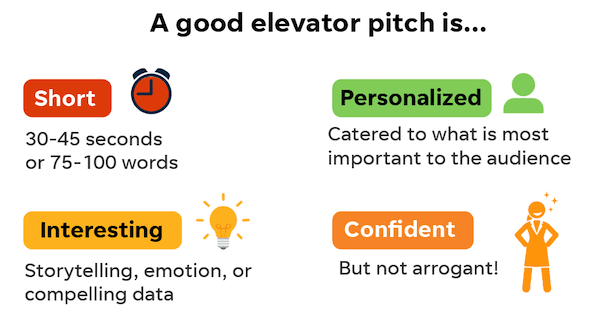Creating an elevator pitch is an essential skill for any entrepreneur, designer, or business professional looking to garner interest in a product, service, or idea.
However, when viewed through the lens of Human-Centered Design (HCD), an elevator pitch becomes more than just a sales pitch.
It’s an opportunity to convey not just the what and how, but the why behind your solution.
Human-Centered Design is a methodology that focuses on deeply understanding and solving the problems of people—your target users.
By aligning your business pitch with this approach, you’re not only communicating the value of your product but also demonstrating a profound understanding of the real-world challenges your audience faces.
In this blog post, we will guide you through the steps involved in creating an effective business elevator pitch, rooted in a Human-Centered Design perspective.
We’ll also explore common mistakes to avoid and offer best practices to enhance your delivery.
What is a Business Elevator Pitch?
A business elevator pitch is a short and persuasive speech that you can use to spark interest in your business, product, or service. It should be delivered quickly—within the time of an elevator ride (usually 30 seconds to 2 minutes)—and should inspire action from your audience, whether it’s investing in your company, trying out your product, or collaborating with you.
However, from a Human-Centered Design perspective, your pitch should do more than just explain your offering.
It should focus on the problem you’re solving, how your solution meets the needs of your users, and why your approach is human-centered.
This means you should emphasize the empathy and understanding that drive your design process.
The Structure of a Human-Centered Business Elevator Pitch
When creating an elevator pitch from a human-centered design perspective, it’s crucial to follow a clear, logical structure.
This will help you convey the core message effectively and guide the listener through your thought process.
1. Introduce the Problem You Are Solving
The first step in any business pitch is to identify the problem you’re tackling. But in the context of Human-Centered Design, you need to approach this problem from the user’s perspective. This is where research comes into play.
Example: “Every year, millions of people struggle to find affordable housing in urban centers. Families and young professionals often spend hours searching for homes, which leads to stress, frustration, and wasted time. What if we could simplify that experience?”
By framing the problem this way, you tap into the pain points of your audience and set the stage for introducing your solution.
2. Explain Your Human-Centered Approach to the Problem
Once the problem is clearly articulated, describe how you approached the challenge using Human-Centered Design principles. This approach involves in-depth user research, empathy-building, and iterative testing to create solutions that truly meet the needs of the people you’re serving.
Example: “To tackle this, we conducted over 100 interviews with prospective homebuyers and renters to understand their needs, preferences, and frustrations. Using these insights, we designed an intuitive, AI-powered app that streamlines the search for affordable housing by learning users’ preferences and matching them with ideal properties in real-time.”
By describing your design process, you show your audience that the solution was built with the user’s needs and experience at the forefront. This demonstrates a deep level of empathy and research, helping build credibility and trust.
3. Present Your Solution
Now that you’ve explained the problem and your research-driven approach, introduce your solution. Highlight the key features, benefits, and differentiators that make your product stand out.
Example: “Our app’s real-time notifications, integrated chat feature, and property filters ensure that users never miss out on a suitable listing. Unlike traditional listing sites, our solution is personalized to each user, reducing the search time by up to 70%.”
It’s essential to emphasize how your solution solves the problem in a way that resonates with your audience’s needs and behaviors. Additionally, make sure to outline what makes your solution different or better than existing alternatives.
4. Share User Feedback or Case Studies
Nothing builds credibility like real-world testimonials or success stories. If you have data, case studies, or feedback from early adopters, this is the place to share it.
Example: “Our beta testers have already seen a 30% increase in housing satisfaction and a 50% reduction in time spent searching for properties. One user, Jane, reported, ‘This app made finding my dream apartment feel effortless—finally, a solution that understands me!’”
User feedback reinforces the authenticity of your pitch, helping your audience connect with the tangible impact your solution is having.
5. Present the Impact of Your Solution
At this point, shift the focus to the larger impact of your solution. What will happen once this problem is solved? How will it benefit the individuals, the industry, or even the world?
Example: “Our solution has the potential to disrupt the housing market by making it easier, faster, and more affordable for individuals to find their homes. Not only will this improve quality of life for millions, but it will also create efficiencies that benefit real estate agents and landlords, leading to a win-win for all stakeholders.”
Emphasize the scale and relevance of your solution to make it clear that your work has significant potential. Demonstrating this impact also signals that you are thinking about the broader picture, not just solving a single problem.
6. Close with a Clear Call to Action
The final step of your elevator pitch should be a clear, actionable request. This could be an invitation to meet again, a call to invest, or an ask to sign up for a demo.
Example: “We are looking for partners who are as passionate as we are about improving the housing experience. Let’s talk about how we can collaborate to bring this solution to the market. Here’s my card—let’s set up a meeting.”
The call to action should be direct and easy to act upon, ensuring your audience knows exactly what to do next if they are interested in your solution.
Best Practices for a Human-Centered Business Elevator Pitch
To increase your chances of success, here are some best practices for delivering an elevator pitch from a Human-Centered Design perspective:
1. Focus on the Problem, Not Just the Solution
Your pitch should start with the problem and why it matters. Too often, entrepreneurs jump straight into talking about their solution, assuming the audience will immediately see its value. Remember, the problem is the hook. Without it, the audience won’t understand why your solution is necessary.
2. Use Real-World Examples
Illustrate your points with concrete examples or case studies. This brings your solution to life and makes it more relatable. Rather than just describing the features of your product, show how it has helped others, or explain how it will directly improve your audience’s life.
3. Keep It Simple
Avoid jargon, complex terminology, and technical speak. Make sure that even someone unfamiliar with your industry can understand your pitch. A simple, straightforward explanation will be more impactful than an overcomplicated one.
4. Know Your Audience
Tailor your pitch to the specific interests and concerns of your target audience. If you’re speaking to investors, focus on the business potential. If you’re speaking to potential users, focus on the benefits they will experience. Understanding your audience’s motivations is key to crafting a pitch that resonates.
5. Practice Your Pitch
An elevator pitch should be natural and confident. Rehearse your pitch until you’re comfortable with the flow and wording. If you fumble or sound unsure, your audience may lose interest. Practice until your delivery feels seamless.
6. Be Prepared for Questions
Anticipate any objections or questions that might arise and be ready with thoughtful responses. Showing that you’ve thought through your solution and its challenges will boost your credibility.
Common Mistakes to Avoid
Despite the best intentions, many entrepreneurs fall into common pitfalls when crafting their elevator pitch. Here are some mistakes to steer clear of:
1. Focusing Too Much on the Solution
While your product or service is central to the pitch, the problem it addresses should always be the focal point. If you don’t make it clear why your solution matters, your audience may not grasp the importance of what you’re offering.
2. Using Jargon or Technical Terms
Avoid using technical or industry-specific language that might confuse or alienate your audience. The goal is to make your pitch accessible to everyone, not just experts.
3. Not Tailoring the Pitch to the Audience
A generic pitch will fail to capture the attention of your specific audience. Whether you’re talking to potential investors, users, or partners, you need to customize your pitch to their unique needs, desires, and concerns.
4. Not Rehearsing the Pitch
A poorly delivered pitch, even if the content is great, can lose its impact. Practice to ensure smooth delivery and a confident presence.
5. Not Being Prepared for Questions
Be ready for the inevitable questions that will arise after your pitch. Not having well-thought-out answers could make you appear unprepared or unknowledgeable.
Conclusion
Creating a business elevator pitch from a Human-Centered Design perspective is an opportunity to showcase your empathy, problem-solving abilities, and the tangible benefits your solution provides.
By focusing on the problem, clearly explaining your user-centered approach, and highlighting the impact of your solution, you can craft a pitch that resonates with your audience and compels them to take action.
To succeed, you need to practice, refine, and deliver your pitch with confidence. By avoiding common mistakes and implementing the best practices outlined here, you’ll be well on your way to delivering a pitch that not only grabs attention but also inspires collaboration and support.
If you want to continue learning about Business Elevator Pitch, you should read “13 (Really) Good Elevator Pitch Examples & Templates (+How to Write Yours)“


